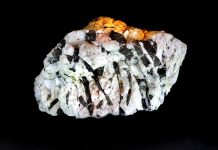
By Jim Brace-Thompson
Calcium aluminum iron sorosilicate Ca2Al2(Fe3+, Al)Si3O12(OH)
Epidote is one terrific silicate mineral for display. It produces well-formed prismatic crystals that are long, slender, striated and translucent with a vitreous (glasslike) luster. It also may form as radial aggregates; that is, as clusters of interconnected crystals radiating out from a central point of connection.
These crystals are relatively hard and durable, at Mohs 6 to 7. Its color adds to its appeal. At its best, epidote is a highly desirable pistachio green, but it also ranges from blackish- to brownish- or yellowish-green.
Iron’s Influence on Color

The amount of iron in a particular specimen influences its color. It is also strongly pleochroic, meaning that as you rotate a crystal, it may show different colors. With epidote, these are usually green, yellow, and/or dark brown.
Epidote forms in regional metamorphic environments. For instance, it is found in contact zones where limestone has been intruded by granite or pegmatites and has been altered to marble. It is also found in igneous rocks where constituent minerals have been hydrothermally altered.
Global Abundance
Epidote is fairly common and abundant, so you should be able to obtain a nice specimen for your collection at a reasonable price at most gem shows or rock shops. Just a few of the many well-known localities are found in France, Austria, the Piedmont region of Italy, Norway, Brazil, Pakistan, and—in the United States—Connecticut, Virginia, Alaska, and elsewhere.
Some especially dark green transparent specimens—especially those from Knappenwand in Austria and from Brazil—have been valued as gemstones for cutting and faceting to be set into jewelry.


















